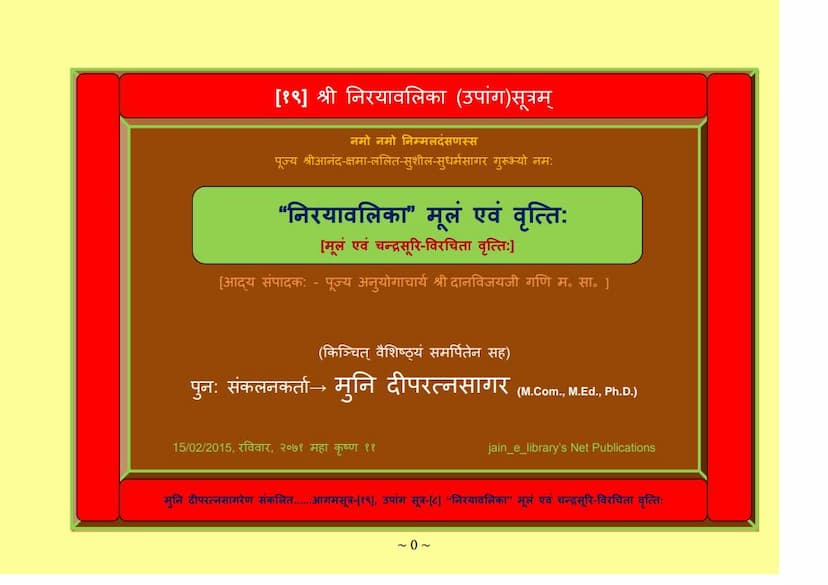Aagam 19 NIRAYAVALIKA Moolam Evam Vrutti
Added to library: September 1, 2025

Summary
This Jain text, "Nirayavalika (Upanga) Sutra" (Book 19 of the Agamas), is a comprehensive work that includes the original Jain scripture ("Moolam") and a commentary ("Vrutti") by Acharya Chandrasuri. The publication itself has a rich history, with the current edition compiled by Muni Diperatnasagar, building upon the foundation laid by Acharya Danvijayji Ganivar.
Key aspects of this publication and the text it presents are:
- Authenticity and Scholarship: The text is presented as a revised and compiled edition, highlighting the scholarly efforts of the compilers and editors. The inclusion of the original Moolam and the Vrutti ensures a deep understanding of the subject matter.
- Structure and Navigation: The book features a detailed index ("Anukram") at the beginning, which guides the reader through the various studies ("Adhyayan") and their corresponding page numbers. This is further enhanced by a "Deep Anukram" which connects this specific publication to other Jain Agam publications by the same publisher, facilitating cross-referencing.
- Focus on "Nirayavalika": As indicated by its title, the primary focus is on the "Nirayavalika" text. The table of contents confirms this, listing "Kaal" (Time) as the first study and then subsequent studies numbered from 2 to 10, detailing various aspects.
- Historical Context of the Edition: The publication's "development story" is shared, explaining that this is a reproduction of an earlier 1922 edition by the Agamoday Samiti, edited by Pujya Danvijayji Gan Maharaj. The author expresses concern about subsequent unauthorized reproductions that omitted the original editor's and publisher's names.
- Purpose of the New Edition: Muni Diperatnasagar's effort is driven by a desire to serve the Agamas and to honor the reverence for ancient acharyas. The new edition was created by scanning the original, formatting it with the Agam name, study, and sutra numbers at the top of each page, and providing the original text with commentary side-by-side. This meticulous approach aims to make the study of the Agamas more accessible and understandable.
- Content of "Nirayavalika": The text, as revealed through the provided pages, narrates stories and teachings related to specific individuals and events within the Jain tradition. The excerpts detail:
- The setting: Often starting with the time and place, like Rajgriha (Rajgir) during the time of Lord Mahavir.
- Key figures: Mentioning prominent disciples of Lord Mahavir like Arya Sudharma and Arya Jambu.
- Narrative style: The text uses the characteristic Jain narrative style, describing the purity, qualities, and actions of individuals.
- Specific stories: The sampled pages introduce the story of King Shrenik, his queens (Padmavati, Kalidevi, Chellana), and their sons (Kunik, Kaal, Vehalla). The narrative delves into the birth of Kunik, his cravings during pregnancy, his upbringing, and the tragic events that unfold, including the death of King Shrenik and the subsequent rise of Kunik to power.
- The "Kaal" Study (First Study): This section focuses on Prince Kaal, his actions, and his subsequent journey to hell ("Niray") due to his karmas, emphasizing the consequences of certain actions. It also touches upon the retribution of his actions in the afterlife and his eventual liberation.
- The "Rathmusal Sangram" (Chariot-Mace Battle): A significant portion of the text describes the conflict between Kunik and King Chetaka, the maternal grandfather of Kunik, involving the sons of Shrenik and their armies. The detailed description of the battle, the strategies, and the devastating impact highlights the karmic consequences of such conflicts.
- The "Kaal" Kumar's Fate: The narrative explicitly connects the negative actions of Kaal Kumar and his participation in the "Rathmusal Sangram" to his rebirth in a hellish realm, hence the name of the study "Kaal" and its placement within the "Nirayavalika".
- Genealogy and Royal Lineages: The text traces the lineage of kings and queens, providing details about their marriages, offspring, and the events that shaped their reigns.
- Karma and Rebirth: The core of the narrative emphasizes the Jain principles of karma and rebirth, illustrating how actions in this life lead to consequences in future lives, including journeys to hellish realms.
- Moral and Spiritual Lessons: Through these stories, the text imparts moral and spiritual lessons about the importance of righteous conduct, the consequences of attachment and desire, and the ultimate path to liberation.
In essence, "Nirayavalika" is a didactic text within the Jain canon, employing historical narratives and biographical accounts to illustrate the principles of karma, rebirth, and the path to spiritual liberation. This particular publication aims to make these teachings accessible to a wider audience with scholarly precision and respect for tradition.